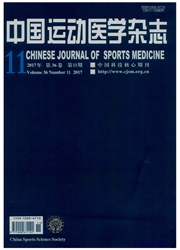

 中文摘要:
中文摘要:
目的:通过观察力竭运动后大鼠前额叶皮层小清蛋白(parvalbumin,PV)阳性神经元的表达变化,探讨运动疲劳对前额叶皮层神经微环路可塑性的影响,同时观察前额叶皮层N-甲基-D-天门冬氨酸受体NR2B亚型(N-methyl-D-aspartatereceptor NR2B subunit,NMDAR2B)表达的变化,进一步探讨运动疲劳中枢调节的可能机制。方法:雄性Wistar大鼠36只随机分为一次力竭运动组、重复力竭运动组和对照组。力竭运动方案采用本实验室改进的Bedford渐增负荷动物运动方案:I级:8.2 m/min,15 min;II级:15 m/min,15 min;III级:20 m/min,至力竭,重复力竭运动组连续进行7天力竭性跑台运动,在运动力竭后采用免疫荧光染色技术观察大鼠前额叶皮层PV阳性神经元的表达情况,并记录阳性细胞个数。采用免疫荧光染色技术和免疫印迹法检测前额叶皮层NMDAR2B的表达情况。结果:一次力竭运动组及重复力竭运动组大鼠前额叶皮层PV阳性神经元个数较对照组显著增加(P〈0.01)。免疫荧光染色结果显示,前额叶皮层NMDAR2B阳性神经元在对照组和重复力竭运动组未见明显表达,一次力竭运动组可见阳性神经元表达;Western blot结果显示,与对照组相比,一次力竭运动组NMDAR2B表达相对较高,而重复力竭运动组表达相对较低,但均无显著性差异(P〉0.05);NMDAR2B表达与运动距离呈显著负相关(P〈0.01,r=-0.936)。结论:力竭运动通过PV阳性神经元的局部环路的调节影响大鼠前额叶皮层神经网络的可塑性,其参与了运动疲劳的中枢调节,为运动疲劳中枢机制研究提供了形态学基础。
 英文摘要:
英文摘要:
Objective To explore the effects of excise-induced fatigue on the microloop plasticity ofprefrontal cortex through observing the expression of parvalbumin positive neurons in prefrontal cortexesof rats induced by exhaustive exercise,so as to find out the possible mechanism of the central regula-tion of exercise-induced fatigue by measuring the expression of NMDAR2 B receptors. Methods Thirty-six Wistar rats were randomly divided into an exhausted group(E),a repeated exhaustion group(RE)and a control group(CG),each of 12. For group E,the adjusted Bedford incremental load of treadmillexercise program was employed:the initial treadmill speed was 8.2 m/min,lasting for 15 minutes,then increased to 15 m/min for another 15 minutes,and finally increased to 20 m/min till exhaustion. ForRE group,they were given continuous treadmill exercises to exhaustion for consecutive 7 days. The im-munofluorescence technique was used to observe the expression of PV+interneurons after exhaustedtreadmill running. The Western blotting technique was used to determine the expression of NMDAR2 Bin the tissue of the prefrontal cortex. Results After the exhausted treadmill running,the expression ofPV+interneurons in the prefrontal cortexes of both E and RE groups increased significantly comparedwith the control group(P〈0.01). The immunofluorescence results indicated that NMDAR2 B positive neu-rons were seen in group E,but not obviously in group CG and RE. The Western blotting showed thatcompared with CG group the protein expression of NMDAR2 B in prefrontal cortexes of group E was rel-atively high,and that of group RE was relatively low,but without significant difference(P〈0.05). Therunning distance and prefrontal cortex NMDAR2 B expression were found negatively correlated(P〈0.01). Conclusions Exhaustive exercises have an impact on the plasticity in rats' prefrontal cortexneural network through regulating the local loop of PV positive neurons. This plasticity of the prefron-tal cortex is involved in the re
 同期刊论文项目
同期刊论文项目
 同项目期刊论文
同项目期刊论文
 期刊信息
期刊信息
